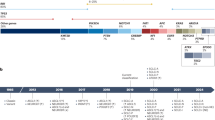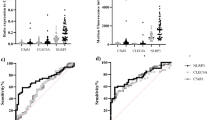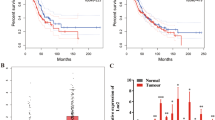Summary
To assess the potential differential lung tumour expression of NAD(P)H:quinone reductase (NQO1), the human (h) NQO1 promoter was characterized in gene transfer studies. A deletion panel of 5′ flanking hNQO1 promoter constructs was made and tested in transient transfection assays in NSCLC and SCLC cell lines. The largest hNQO1 construct (–1539/+115) containing the antioxidant response element (ARE), exhibited robust levels of reporter activity in the NSCLC (H460, H520, and A549) cell lines and expression was over 12 to 77-fold higher than the minimal (–259/+115) promoter construct. In contrast, there was little difference in promoter activity between the largest and minimal promoter construct in the SCLC (H146, H82 and H187) cell lines. Deletion of the sites for NFκB and AP-2 and the XRE did not significantly affect hNQO1 promoter activity in either the NSCLC or SCLC cell lines. Robust promoter activity in NSCLC lines was mediated by a 359 bp segment of the proximal promoter that contained a canonical AP-1 binding site, TGACTCAG, within the ARE. Gel supershift assays with various specific Fos/Jun antibodies identified Fra1, Fra2 and Jun B binding activity in NSCLC cells to a promoter fragment (–477 to –438) spanning the AP-1 site, whereas SCLC do not appear to express functional Fra or Jun B. These results suggest a possible role for AP-1 activity in the differential expression of hNQO1 in NSCLC.
Similar content being viewed by others
Article PDF
Change history
16 November 2011
This paper was modified 12 months after initial publication to switch to Creative Commons licence terms, as noted at publication
References
Angel, P. & Karin, M. (1991). The role of Jun, Fos and the AP-1 complex in cell proliferation and transformation. Biochim Biophys Acta 1072: 129–157.
Benson, A. M., Hunkeler, M. J. & Talalay, P. (1980). Increase of NAD(P)H: quinone reductase by dietary antioxidants. Possible role in protection against carcinogenesis and toxicity. Proc Natl Acad Sci USA 77: 5216–5220.
Berger, M. S., Talcott, R. E., Rosenblum, M. L., Silva, M., Ali-Osman, F. & Smith, M. (1985). The use of quinones in brain tumor chemotherapy. Preliminary results from preclinical investigations. J Toxicol Environ Health 16: 713–719.
Bergers, G., Graninger, P., Braselmann, S., Wrighton, C. & Bussinger, M. (1995). Transcriptional activation of the Fra-1 gene by AP-1 is mediated by regulatory sequences in the first intron. Mol Cell Biol 15: 3748–3758.
Beyer, R. E., Segura-Aguilar, J., Lind, C. & Castro, V. M. (1987). DT-diaphorase activity in various cells in culture with emphasis on induction in ascites hepatoma cells. Chemica Scripta 27A: 145–150.
Busslinger, M. & Bergers, G. (1994). Identification of AP-1 regulated genes. In The Fos and Jun Families of Transcription Factors, Angel PE and Herrlich PA (eds), pp. 133–150. CRC Press: Boca Raton, FL
Chiu, R., Angel, P. & Karin, M. (1989). JunB differs in its biological properties from, and is a negative regulator of cJun. Cell 59: 979–986.
Cohen, D. R. & Curran, T. (1988). Fra-1: a serum-inducible cellular immediate: early gene that encodes a fos-related antigen. Mol Cell Biol 8: 2063–2069.
Coussens, L. M., Yokoyama, K. & Chiu, R. (1994). Transforming growth factor beta 1-mediated induction of JunB is selectively inhibited by expression of Ad. 12-E1a. J Cell Physiol 160: 435–444.
DeLong, M. J., Prochaska, H. J. & Talalay, P. (1986). Induction of murine hepatoma cells by phenolic antioxidants, azo dyes and other chemoprotectors: a model system for the study of anticarcinogens. Proc Natl Acad Sci USA 83: 787–791.
Diccianni, M. B., Imagawa, M. & Muramatsu, M. (1992). The dyad palindromic glutathione transferase P enhancer binds multiple factors including AP-1. Nucleic Acids Res 20: 5153–5158.
Dignam, J. D., Lebovitz, R. & Roeder, R. G. (1983). Accurate transcription initiation by RNA polymerase II in a soluble extract from isolated mammalian nuclei. Nucleic Acids Res 11: 1475–1489.
Ephrussi, A., Church, A., Tonegawa, S. & Gilbert, W. (1985). β lineage-specific interactions of an immunoglobulin enhancer with cellular factors in vivo. Science 227: 134–140.
Friling, R. S., Bergelson, S. & Daniel, V. (1992). Two adjacent AP-1 like binding sites form the electrophilic-responsive element of the murine glutathione S-transferase Ya subunit gene. Proc Natl Acad Sci USA 89: 668–672.
Jaiswal, A. K. (1991). Human NAD(P)H:quinone oxidoreductase (NQO1) gene structure and induction by dioxin. Biochemistry 30: 10647–10653.
Jaiswal, A. K., McBride, O. W., Adesnik, M. & Nebert, D. W. (1988). Human dioxin inducible cytosolic NAD(P)H:menadione oxidoreductase. J Biol Chem 263: 13572–13578.
Joseph, P., Jaiswal, A. K., Stobbe, C. C. & Chapman, J. D. (1994). The role of specific reductases in the intracellular activation and binding of 2-nitroimidazoles. Int J Radiat Oncol Biol Phys 29: 351–355.
Karin, M., Liu, Z. & Zandi, E. (1997). AP-1 function and regulation. Curr Opin Cell Biol 9: 240–246.
Kovary, K. & Bravo, R. (1992). Existence of different Fos/Jun complexes during the G0 to G1 transition and during exponential growth in mouse fibroblasts: differential role of Fos proteins. Mol Cell Biol 12: 5015–5023.
Li, Y. & Jaiswal, A. K. (1992). Regulation of human NAD(P)H:quinone reductase gene. Role of AP-1 binding site contained within human antioxidant response element. J Biol Chem 267: 15097–15104.
Li, Y. & Jaiswal, A. K. (1994). Human antioxidant response element regulation of type 1 NAD(P)H:quinone oxidoreductase gene expression. Eur J Biochem 226: 31–39.
Malkinson, A. M., Siegel, D., Forrest, G. L., Gazdar, A. F., Oie, H. K., Chan, D. C., Bunn, P. A., Mabry, M., Dykes, D. J., Harrison, S. D. Jr & Ross, D. (1992). Elevated DT-diaphorase activity and messenger RNA content in human non-small cell lung carcinoma: relationship to the response of lung tumour xenografts to mitomycin C. Cancer Res 52: 4752–4757.
Milivojevic, B. K. & Gardner, D. G. (1992). Divergent regulation of the human atrial natriuretic peptide gene by c-jun and c-fos. Mol Cell Biol 12: 292–301.
Milivojevic, B. K. & Gardner, D. G. (1995). Fra-1, a Fos gene family member that activates atrial natriuretic peptide gene transcription. Hypertension 25: 679–682.
Prestera, T., Holtzclaw, W. D., Zhang, Y. & Talalay, P. (1993). Chemical and molecular regulation of enzymes that detoxify carcinogens. Proc Natl Acad Sci USA 90: 2965–2969.
Ryseck, R. P. & Bravo, R. (1991). cJun, Jun B, and Jun D differ in their binding affinities to AP-1 and CRE consensus sequences: effect of Fos proteins. Oncogene 6: 533–542.
Schlager, J. J. & Powis, G. (1990). Cystolic NAD(P)H: (quinone acceptor) oxidoreductase in human normal and tumor tissue: effects of cigarette smoking and alcohol. Int J Cancer 45: 403–409.
Shy, M. E., Shi, Y., Wrabetz, L., Kamholz, J. & Scherer, S. S. (1996). Axon–schwann cell interactions regulate the expression of c-jun in Schwann cells. J Neurosci Res 43: 511–525.
Smitskamp-Wilms, E., Giaccone, G., Pinedo, H. M., Van der Laan, BFAM & Peters, G. J. (1995). DT-diaphorase activity in normal and neoplastic human tissues: an indicator for sensitivity to bioreductive agents. Br J Cancer 72: 917–921.
Suzuki, T., Okuno, H., Yoshida, T., Endo, T., Nishina, H. & Iba, H. (1991). Differences in transcriptional regulatory function between cFos and Fra-2. Nucleic Acids Res 19: 5537–5542.
Szabo, E., Riffe, M. E., Steinberg, S. M., Birrer, M. J. & Linnoila, R. L. (1996). Altered cJun expression: an early event in human lung carcinogenesis. Cancer Res 56: 305–315.
Talalay, P. & Prochaska, H. J. (1987). Mechanisms of induction of NAD(P)H:quinone reductase. Chemica Scripta 27A: 61–66.
Talalay, P., DeLong, M. J. & Prochaska, H. J. (1988). Identification of a common chemical signal regulating the induction of enzymes that protect against chemical carcinogenesis. Proc Natl Acad Sci USA 85: 8261–8265.
Traver, R. D., Siegel, D., Beall, H. D., Phillips, R. M., Gibson, N. W., Franklin, W. A. & Ross, D. (1997). Characterization of a polymorphism in NADP(H):quinone oxidoreductase (DT-diaphorase). Br J Cancer 75: 69–75.
Venugopal, R. & Jaiswal, A. K. (1996). Nrf1 and Nrf2 positively and cFos and Fra-1 negatively regulate the human antioxidant response element-mediated expression of NAD(P)H:quinone reductase 1gene. Proc Natl Acad Sci USA 93: 14960–14965.
Wang, B. & Williamson, G. (1994). Detection of a nuclear protein which binds specifically to the antioxidant responsive element (ARE) of the human NAD(P)H:quinone oxidoreductase gene. Biochim Biophys Acta 1219: 645–652.
Welter, J. F., Crish, J. F., Agarwal, C. & Eckert, R. L. (1995). Fos-related antigen (Fra-1), JunB and JunD activate human involucrin promoter transcription by binding to proximal and distal AP-1 sites to mediate phorbal ester effect on promoter activity. J Biol Chem 270: 12614–12622.
Wisdom, R. & Verma, I. M. (1993). Transformation by Fos proteins requires a C-terminal transactivation domain. Mol Cell Biol 13: 7429–7438.
Xanthoudakis, S., Miao, G., Wang, F., Pan, Y. C. & Curran, T. (1992). Redox activation of Fos-Jun DNA binding activity is mediated by a DNA repair enzyme. EMBO J 11: 3323–3335.
Yoshioka, K., Deng, T., Cavigelli, M. & Karin, M. (1995). Antitumor promotion by phenolic antioxidants: inhibition of AP-1 activity through induction of Fra expression. Proc Natl Acad Sci USA 92: 4972–4976.
Author information
Authors and Affiliations
Rights and permissions
From twelve months after its original publication, this work is licensed under the Creative Commons Attribution-NonCommercial-Share Alike 3.0 Unported License. To view a copy of this license, visit http://creativecommons.org/licenses/by-nc-sa/3.0/
About this article
Cite this article
Kepa, J., Ross, D. DT-diaphorase activity in NSCLC and SCLC cell lines: a role for fos/jun regulation. Br J Cancer 79, 1679–1684 (1999). https://doi.org/10.1038/sj.bjc.6690268
Received:
Revised:
Accepted:
Published:
Issue date:
DOI: https://doi.org/10.1038/sj.bjc.6690268
Keywords
This article is cited by
-
Induction of p53-mediated senescence is essential for the eventual anticancer therapeutic effect of RH1
Archives of Pharmacal Research (2019)
-
Phase 1 study of ARQ 761, a β-lapachone analogue that promotes NQO1-mediated programmed cancer cell necrosis
British Journal of Cancer (2018)
-
Effect of NQO1 induction on the antitumor activity of RH1 in human tumors in vitro and in vivo
Cancer Chemotherapy and Pharmacology (2005)
-
Dietary induction of NQO1 increases the antitumour activity of mitomycin C in human colon tumours in vivo
British Journal of Cancer (2004)
-
Expression of the prodrug-activating enzyme DT-diaphorase via Ad5 delivery to human colon carcinoma cells in vitro
Cancer Gene Therapy (2002)



